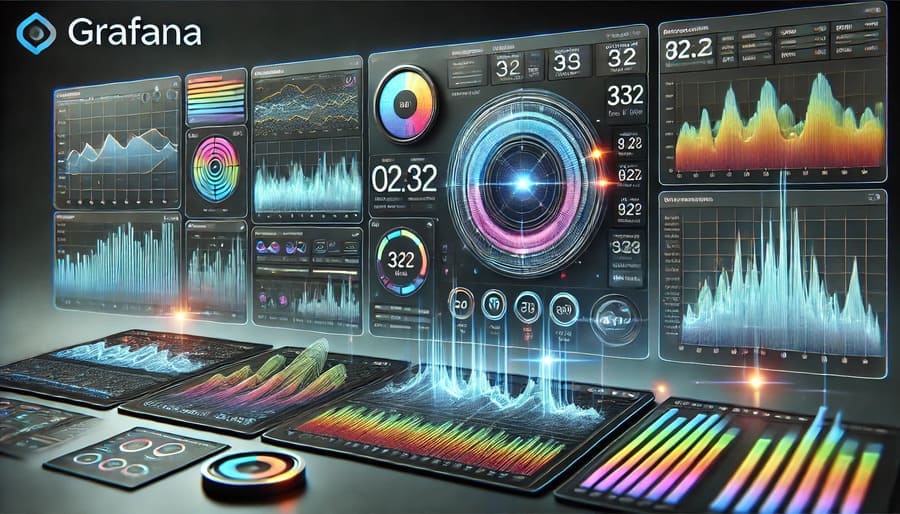Grafana

In the data-driven world we live in, making sense of complex information isn’t just a luxury—it’s a necessity. Enter Grafana, an open-source platform that has revolutionized how organizations visualize, analyze, and monitor their metrics. Whether you’re tracking server performance, business KPIs, or IoT sensor data, Grafana transforms raw numbers into actionable insights through beautiful, interactive dashboards.
At its core, Grafana is a visualization tool, but calling it just that would be like calling a Swiss Army knife merely a blade. Grafana excels because it combines powerful visualization capabilities with extensive data source compatibility and a flexible, plugin-based architecture.
Unlike many visualization tools that lock you into specific data sources, Grafana plays well with almost everything:
- Time-series databases: Prometheus, InfluxDB, Graphite
- SQL databases: MySQL, PostgreSQL, Microsoft SQL Server
- Cloud platforms: AWS CloudWatch, Google Cloud Monitoring, Azure Monitor
- IoT and application data: Elasticsearch, MongoDB, OpenTSDB
This flexibility means you can bring together data from multiple sources into unified dashboards—no more toggling between different tools to get the complete picture.
Grafana shines in operational contexts where real-time monitoring is crucial:
- Live updates: Dashboards refresh automatically at configurable intervals
- Interactive exploration: Zoom in on specific time ranges, hover for details
- Alerting: Set thresholds and receive notifications when metrics cross boundaries
- Annotations: Mark deployments, incidents, or important events on your graphs
While line graphs are Grafana’s bread and butter for time-series data, its visualization repertoire extends far beyond:
- Gauges and stat panels: For at-a-glance performance indicators
- Heat maps: Perfect for showing distribution patterns
- Tables: When you need the raw numbers
- Geomaps: For location-based analytics
- Pie charts and bar graphs: For comparative analysis
- Custom panels: Via the thriving plugin ecosystem
One of Grafana’s strengths is its accessibility. You can have a basic instance running in minutes:
# Using Docker
docker run -d -p 3000:3000 grafana/grafana-enterprise
# Or on Ubuntu/Debian
sudo apt-get install -y apt-transport-https
sudo apt-get install -y software-properties-common wget
wget -q -O - https://packages.grafana.com/gpg.key | sudo apt-key add -
echo "deb https://packages.grafana.com/enterprise/deb stable main" | sudo tee -a /etc/apt/sources.list.d/grafana.list
sudo apt-get update
sudo apt-get install grafana-enterprise
sudo systemctl start grafana-server
After installation, access the web interface at http://localhost:3000 with the default credentials (admin/admin).
DevOps teams live and breathe Grafana for infrastructure monitoring:
- Server CPU, memory, and disk utilization
- Network traffic and latency
- Application performance metrics
- Incident response timelines
- Kubernetes cluster health
Beyond IT, Grafana helps business teams visualize:
- E-commerce conversion funnels
- Marketing campaign performance
- Customer acquisition costs
- User engagement metrics
- Revenue and growth trends
In the physical world, Grafana visualizes:
- Smart home energy consumption
- Factory equipment performance
- Environmental sensors (temperature, humidity)
- Agricultural data (soil moisture, crop yields)
- Transportation fleet metrics
As you grow comfortable with Grafana, explore these powerful capabilities:
Grafana’s alerting system has evolved into a sophisticated platform for:
- Multi-dimensional alerting based on complex conditions
- Notification routing to Slack, email, PagerDuty, and more
- Alert templating with rich context
- Silences and maintenance windows
The transformations feature lets you reshape your data on the fly:
- Join multiple queries
- Perform calculations across queries
- Filter and organize results
- Convert time series to tables or vice versa
Variables make your dashboards dynamic and reusable:
- Filter dashboards by server, application, or environment
- Compare metrics across different time periods
- Create drill-down hierarchies
- Allow users to customize their views
Grafana thrives because of its vibrant community and dual licensing model:
- Grafana Open Source: Free forever, with all the core visualization capabilities
- Grafana Enterprise: Adds advanced authentication, data source permissions, reporting, and enterprise plugins
Whether you’re a solo developer or a Fortune 500 company, there’s a Grafana offering that fits your needs.
Creating your first dashboard is straightforward:
- Add a data source (Prometheus is popular for beginners)
- Create a new dashboard
- Add a panel
- Write a query (or use the visual query builder)
- Customize visualization settings
- Save and share your creation
The best way to learn is by doing—start simple, then add complexity as you become more comfortable.
In a landscape filled with visualization tools, Grafana stands out for its flexibility, power, and ease of use. Whether you’re monitoring cloud infrastructure, analyzing business metrics, or visualizing scientific data, Grafana provides the tools to transform raw numbers into meaningful insights.
As data volumes grow and systems become more complex, tools like Grafana aren’t just nice to have—they’re essential for maintaining visibility and making informed decisions. Start small, experiment often, and watch as your dashboards evolve from simple graphs to comprehensive analytics platforms.
#Grafana #DataVisualization #Monitoring #Analytics #Dashboards #DevOps #TimeSeriesData #OpenSource #DataObservability #MetricsMonitoring